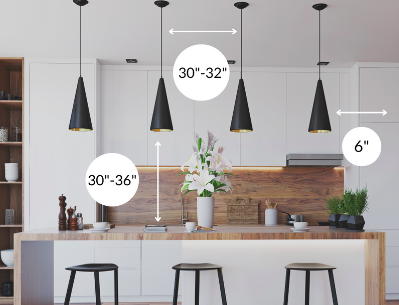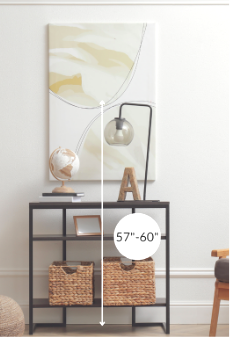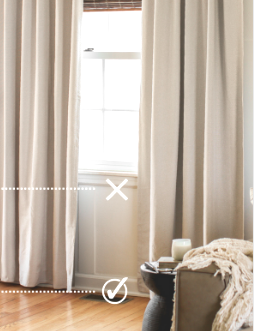LIGHT FIXTURES
Whether it is a foyer or great room chandelier, sconces in your bathroom, or pendants over your island, it is important to install them correctly so that the room feels balanced. Now, with these general guidelines, there are always exceptions depending on the style of the room, the type of fixture and the surface underneath the light.

Chandelier in Great Room/Foyer
We are seeing the return of large light fixtures in great rooms and foyers. You want to be mindful of what is happening beneath and around the light. There may be a seating arrangement, a staircase, or just an open space. It may be a single-storey room, or a two-storey (loft-style space). There may even be a bank of windows that will affect its placement.
- Place the light fixture in the centre of the room, or over the main vignette/arrangement
- For a single-storey space, make sure to have at least 7 feet of clearance from the floor to the bottom of the light fixture
- For a two-storey room, hang the fixture no lower than the start of the second storey so that it isn’t in the first storey’s air space
- If there are windows on the second storey, you may want to consider hanging the fixture centred on the windows
Pendants in the Kitchen
The number of pendants to hang over a kitchen island or peninsula will depend on a few factors: the size of the island, the size of the light fixture and personal preference. Keep these general guidelines in mind:
- There should be at least 6” from the edge of the island to the first hung pendant
- Leave 30”-36” between the top of the counter and the bottom of the pendant
- Don’t crowd the pendants – leave 30”-32” in between each pendant
Chandelier Over Dining Table
The height of your light fixture over your dining table is dependent on the height of your ceiling. You want to avoid hanging it too high so that when you’re seated it feels so far away, but you also don’t want the light bulbs dipping into your dinner.
- 8-foot ceilings: 32” – 36” between the top of your table and the bottom of your fixture
- 9-foot ceilings: 36”– 40” between the top of your table and the bottom of your fixture
- 10-foot ceilings: 40” – 44” between the top of your table and the bottom of your fixture

ARTWORK
Incorrectly hung artwork is the #1 design issue we see in homes – artwork that is hung too high, too small, and too far apart. We’ll discuss how hanging curtains high makes the room look taller below, however, that same concept DOES NOT apply to artwork.
Hang single or side-by-side art pieces at eye level
- 57” – 60” from floor to the centre of the art
- You want to be able to stand and be looking at the centre of the art piece
Keep the artwork scale in mind while hanging it close to the furniture below
- If the art piece is being hung over a console table, or over a couch, the rule of thumb is to leave 4”- 6” of space from the top of the furniture piece to the bottom of the art
- Artwork should be 2/3 the size of the furniture below it
Hang multiple pieces as if they are one
- Make sure to leave only a few inches between the art pieces to avoid them feeling disconnected
- If hanging a gallery wall of art, leave 2”-3” between the frames

CURTAINS
When it comes to window coverings, curtains are an affordable and functional option. When hung correctly, they are also useful in “tricking the eye” to make your windows look larger and your ceilings appear taller.
The Higher the Better
The placement of the curtain rod is very important and should be hung in relation to the ceiling, not the window. A general rule of thumb is to divide the space between the ceiling and the top of the window frame into thirds and install the rod 1/3 down from the ceiling. Now with an 8ft ceiling height, that will mean your rod will be quite close to the ceiling and that is OKAY! Hanging the rod higher will mean you will have longer curtains (see Tip #3) which naturally draws your attention upwards, making the ceiling appear higher than it is.
Wider Than Your Window
We can also use curtains to make windows seem wider than they are. Extending the rod 6 inches past either side of the window makes it look more expansive, and gives you more space to pull the drapes back and let the light in. While executing this trick, remember to keep the inside of the panels flush with the window trim for the illusion they’re covering a wider window.
Kiss the Floor
There is nothing worse than curtains hung too short. The best way to determine curtain length is to first measure the distance between the floor and the height of the curtain rod and then round up to the nearest panel size. Most standard curtain lengths are 63”, 84″, 96″, 108″ and 120” inches. Generally, the drapery that hovers about ½ inch off the ground “kissing the floor” provides a crisp and clean look. One exception to this rule: if you are going for a more romantic touch, add 4 to 6 inches to allow for puddling on the floor.
Written by Ashlee Mclean
Real Estate Sales Representative
Coldwell Banker Community Professionals, Brokerage

 Facebook
Facebook
 X
X
 Pinterest
Pinterest
 Copy Link
Copy Link


